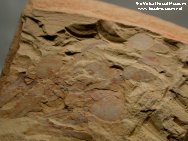Longtancunella chengjiangensis
Geological Time: Lower Cambrian (~525 million years ago)
Size: up to 30 mm
Fossil Site: Chengjiang Maotianshan Shales, Quiongzhusi Section, Yu’anshan Member, Heilinpu Formation, Mao Tian Hill, Anning, Kunming, Yunnan Province, China
The diversity of soft-tissue fossils is astonishing: algae, medusiforms, sponges, priapulids, annelid-like worms, echinoderms, arthropods (including trilobites), hemichordates, chordates, and the first agnathan fish make up just a small fraction of the total. Numerous problematic forms are known as well, some of which may have represented failed attempts at diversity that did not persist to the present day. Lingulella is a widespread Cambrian lingulid brachiopod, also found in the Burgess Shale. Specimens from that locality do not typically show soft tissue preservation such as the pedicle seen here. While it may have led a burrowing existence like modern-day lingulids, the fact that most have been found attached to others of its type is indicative of an epibenthic lifestyle. This species has been reported from both Chengjiang and Haikou locales, but remains a rare specimen. This specimen comes from Maotianshan (Mao Tian Hill), the site of the original discovery of the Chengjiang Biota. Zhang Z-F., Shu D-G., Han J. & Liu J-N. 2007: A gregarious lingulid brachiopod Longtancunella chengjiangensis from the Lower Cambrian, South China. Lethaia, Vol. 40, pp. 11–18. Also see: Chengjiang Biota Chengjiang Fossils Cambrian Explosion |




